|
Africa
2024 Journal Pages:
1
2
3
4
5
6
7
8
9
10
11
12
January
9
Our wake-up call came at five; normally
I detest getting up that early, but in Africa I am always ready to
be out before the crack of dawn. We had breakfast at 5.30, and
were on the road by six. We’d barely left the camp when we met
up with a large male giraffe. We were able to get quite close to
him, and sat quietly in the vehicle watching him browse the tree
branches.
There were a number of birds and animals we saw on pretty
much every gave drive, such as the inevitable impalas, francolin
and starlings. There were many others that we saw on most drives
as well; among them were zebras, elephants, wildebeests, warthogs,
steenboks, doves, and Guinea fowl. In the interest of avoiding
redundancy, for the purpose of this journal I am not going to
mention every time we sighted the various more common birds and
animals; rather I will record first sightings, and any
particularly notable encounters.
I had told Gee that one thing I wanted to
see on this trip was a dung beetle, rolling a ball of dung. I had
seen these in TV documentaries, but never in real life.
Sure enough, Gee spotted one in the road, and we all got
out for a closer look. It was fascinating! The male beetle was
rolling a ball of dung about the size of a tennis ball, while the
female clung to its side, sort of embedded into the ball and not
moving as it rolled over and over her. She must have laid her eggs
in the ball, or was getting ready to.
The poor father dung beetle was trying to push the ball up
a small slope on the side of the tire track, but it was very
difficult, and every time he got it almost to the top he
lost control of it and it rolled back down. We were all routing
for him to succeed – come on, go boy, go! Finally he was able to
maneuver the dung ball to what he considered a satisfactory spot,
and then he started to bury it by digging the sand out from under
it. The female beetle
seemed to wake up at this point, and Gee said she was checking the
dung ball to see if it was satisfactory. I thought she should have
done that before her mate went to all that trouble pushing it up
the slope. Fortunately it seemed to pass inspection, and we
watched the ball slowly sink down into the sand as the beetle
excavated underneath it, until it was barely visible.
We drove along a broad open
area fringed with forest. A pair of African hawk eagles sat in a
tall tree, scanning the plains.
A bit further on we spotted a handsome Senegal coucal
perched on a branch; these striking crow-sized birds are vivid
black and white with chestnut wings and red eyes. We spotted a
jackal, running purposefully through the grass.
We
were driving across an open plain when ahead of us we saw a lone
male lion, stalking imperiously across the veldt. He was
magnificent! He exuded raw power and confidence - there was no
question that he was the king of the beasts. Watching him, I was
absolutely spellbound by his beauty.
The
lion’s flowing mane looked as if it had just been brushed and
styled. This was one of the most stunning lions I have ever seen;
he looked like a cross between Mufasa
from the Lion King and the model Fabio.
He stopped to pose for photos several times, and then continued on
regally. ‘Oh my god, my father,’ Gee murmured softly. Natalie told Janell
“That is the phrase you want to hear from Gee; it means we have
spotted something wonderful.” The phrase sort of became our
mantra for the trip after that.
We followed the two lions as they moved
across the clearing, and then into a more forested area. Gee would
drive ahead of them and stop, and we would watch in awe as they
strode past us. They took no notice of us; Gee had explained that
as long as we are in the vehicle, the animals don’t really see
us as people, but just as part of the land cruiser. After a while
the two lions lay down for a nap; the hunt could wait until
evening. We left them to their slumbers and continued on.
We drove across another dead
tree forest; I am not sure if that is a common term or just
Gee’s name for it, but this wide expanse of dead trunks had
virtually no living trees among them. It looked sort of
depressing, but on the other hand the elephants’ wasteful
feeding habits may be part of nature’s plan; they help prevent
the whole area from growing up in trees, providing some areas of
open plains.
Two tawny eagles, named for
their color, stood like sentinels near the top of one of the dead
trees; I find them to be one of the most beautiful of the birds of
prey. We watched as they took flight. We saw two pairs of European
bee-eaters; Gee explained that they migrate all the way from
Europe, and return to the same particular tree each year.
After
about an hour we checked back in on our two lions, but they were
pretty quiet, slumbering under the bushes. Fabio of the big mane
got up again and walked a ways, but by now he seemed to have had
enough of the paparazzi (us), so we left him in peace.
Gee showed us a number of
tracks in the road; aside from the spoor (what they call animal
footprints in southern Africa) of our lions, there were also
cheetah and aardvark tracks. We would have loved to see either of
these elusive animals, but we knew that was unlikely. Nonetheless,
we scanned the savannah for cheetahs as we drove along – they
love the open plains where they can sit on a termite mound and see
a long way – but regrettably we saw none.
A
brown and white bird perched on a bush; Gee told us it was a honey
guide. These industrious birds will locate a bee’s hive, and
being unable to open the hive themselves, they will lead either
honey badgers or people to the tree to do so. After the hive is
opened they can feast on the honey or the bee larvae. Legend has
it that if a honey guide leads you to a hive, when you open it you
must leave some for the bird, or next time he will lead you to
lions.
|
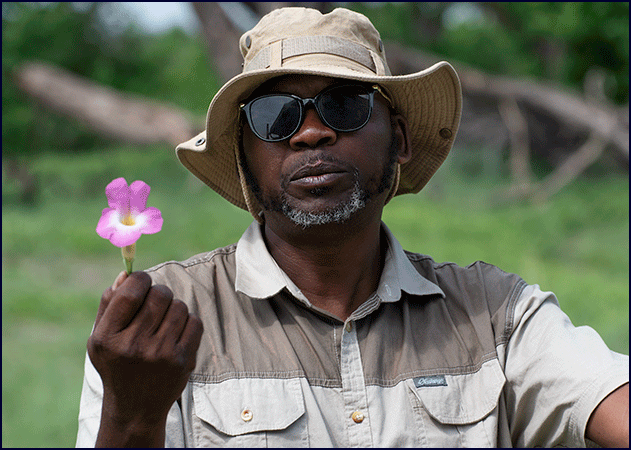
Gee holding a devil's
claw flower |
We
stopped for tea by the same waterhole as yesterday, but on the
other side. We stood in the shade of a tree, listening to the cape
turtle doves chanting Bots-wa-na,
Bots-wa-na. Gee showed us a lovely flower that looked like a
pink morning glory; he said it was called devil’s claw, and has
many medicinal uses.
We watched the elephants come
down to drink. Several big males stood in the edge of the
waterhole; after quenching their thirst they sucked up great
trunkfulls of mud and water and sprayed it over their backs,
liberally coating themselves in dark muck. This would be both
nature’s sunscreen and insect repellent.
We noticed we were seeing all
male elephants again; it is interesting how many of the African
animals separate into bachelor herds and breeding herds, with the
members of the sexes living apart. We saw this same behavior in
impala, and wildebeests, among others.
We stopped just before noon
and parked under a spreading tree. We set up the camp chairs in a
semi-circle and enjoyed an excellent lunch that Mosa and Kilos had
packed for us. Zebras
lounged nearby, and a red-billed hornbill flitted among the
branches above us. After lunch we sat in the shade and told
stories and jokes. It was a pleasant break; we rested there for
nearly two hours. The weather was warm, and we had to keep moving
our chairs to follow the shade as it moved around the tree.
Around two o'clock we left our
lunch spot and moved on. We soon came upon a herd of zebras with
several small babies. They were hanging out in the shade
companionably, and some went down to a waterhole to drink. They
were not too shy, and let us get quite close - we enjoyed watching
the herd interact. The zebras seemed as interested in watching us
as we were in watching them. They vocalized their feelings a bit;
their call does not sound at all like the noise you would expect a
zebra to make - it is sort of a high-pitched cross between a bray
and a whoop.
As we drove on the clouds
rolled in, and we could see storms gathering all around us. There
were some very black clouds in the distance, and god’s rays
slanting down when a break in the cloudy skies let slanting shafts
of sunlight through. A black-backed jackal crossed the road in
front of us, and vultures soared overhead, searching. Four
ostriches danced across the plain in the distance.
Ahead of us there was a line
of trees, and on the far side of it we could see several large
antelopes. ‘Elands!’ Gee told us excitedly. ‘Oh my god, my father,’ he added, and Janell went wild on hearing
that phrase, surely an indicator of amazing wildlife encounters.
After that, the phrase became sort of our mantra for the trip.
Elands
are the largest of the antelopes, and they remind me slightly of Brahma
cattle. They are not all that common and very shy, so it is
difficult to find them. I had never seen an eland on any of my
trips with Gee, so I was really excited. We could make out the
large antelopes through our binoculars; there were at least four
of them. Could we get closer? Gee drove slowly toward them, trying
to approach without alarming them.
We noticed a whitish haze
underneath the trees ahead, spreading over the ground around the
elands. Was it smoke, someone said? Dust from some animals
stampeding, someone else suggested? Mist, I thought. Gee said,
‘It’s rain,’ but we quickly dismissed that idea; it didn’t
look like rain at all.
We
were just getting a little closer to the elands when all at once a
huge storm was over us, complete with lightning and thunder, and
the rain was pouring down, blowing sideways in the sudden wind. We
were drenched in moments. We (and by we
I mean mostly Gee) struggled to roll the plastic sides of the
land cruiser down. ‘My god, my father,’ Gee said again, and this time it seemed to be
prompted by a combination of wonder at the force of nature’s
power, and amazement at our stupidity in disregarding his
knowledge of the weather. Smoke indeed.
Later
we reflected on our folly. Gee, who grew up here and knows the
area like the back of his hand, had told us the white haze was
rain - but instead of listening, we disputed it in favor of our
own theories about smoke or stampede dust. How could we have been
so clueless? Throughout
the rest of the trip every time it rained, which was pretty much
every day, we would ask one another, ‘Is that dust from a
stampede? Or smoke?’
|
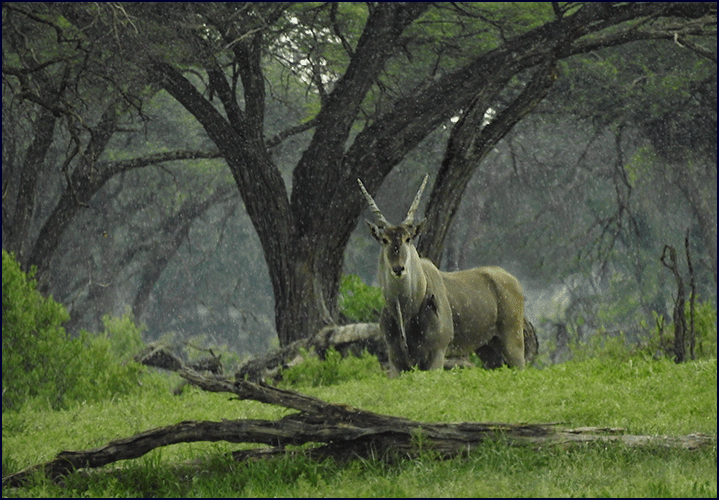
Eland |
Gee told us that after the
rain, everything would be fresh and the animals would be very
active. Sure enough, as we drove on we saw zebras and wildebeests
running back and forth, and the impala were playing. Amur falcons
sailed along beside our vehicle, hundreds of them, flying circles
around us - Gee said they were migrating to the Kalahari
Desert.
Africa is great to visit both
in the dry season and in the rainy season; each time of year has
its pros and cons. In the dry winter season, such as June, July,
or August, animals have to come to the water holes or the Delta to
drink, so it is easier to find them. The sky is nearly always
clear and the weather is lovely, chilly at night and usually in
the seventies or low eighties in the day. The stars at night are
amazing. This is the high season, generally considered the best
time to visit southern Africa. But during the rainy season Africa
is transformed into a green paradise. The animals are sleek and
glossy, the landscape is green and lush, and best of all, that is
when many of the animals have babies. Also, being the low season,
one often hardly sees another vehicle. I love going both times,
and prefer to alternate between seasons on different trips.
|
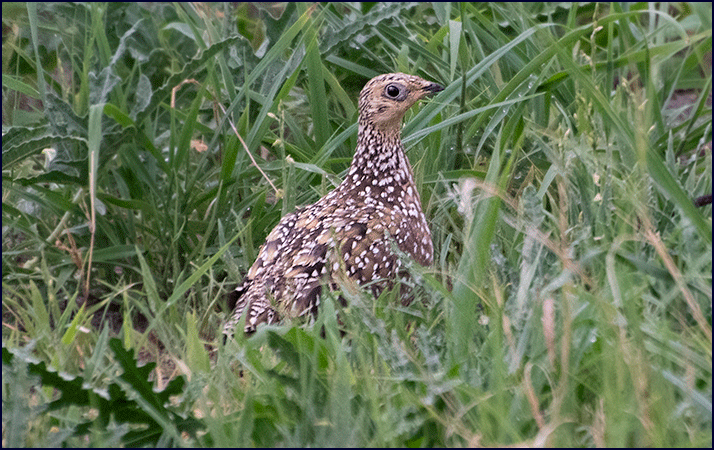
Burchell's sand grouse |
As we headed back toward camp,
a pair of Burchell’s sand grouse pecked through the grass beside
the road, dainty and exquisite. A juvenile tawny eagle perched in
the top of a tree. We
passed an elephant in the fading light. There were storms all
around us. Or was that smoke?
It
had been a wonderful day, and a long one. We sat around the table
(in lieu of the campfire, since it was rainy), most of us with a
glass of wine or a gin and tonic, and discussed the day’s best
sightings. We were all in agreement that our two male lions were
the highlight of the day. Or the elands. Oh, and don’t forget
the dung beetle . . .
When
we left Maun I had told Gee that two things I really wanted to see
were a dung beetle rolling a dung ball, and elands. And here it
was just the second full day, and he had already shown us both!
After dinner we told some
stories and jokes and played some murder-mystery guessing games
until it was time to go to our tents.
I slept on top of the blankets; I didn’t need them for
warmth, and it made the bed a little softer.
The
temperature was still quite warm so I used a trick I had learned
while reading about Africa; I doused my sleeping shirt with water
and lay on the camp bed wet. I was pleasantly cool through the
night, and when I awoke in the morning my shirt was dry.
I
went to sleep listening to the distant whuffing calls of lions.
January
10
We were woken at five again to a
beautiful morning. The coffee was excellent, brewed in a pot
sitting in the embers of the campfire. We woofed down some jungle
oats and toast, and we were in the land cruiser and heading out
into the bush at six as the sun rose.
The
impalas were running; a group of young adults were racing in
circles, chasing each other for fun and exercise. A trio of
yearling warthogs gazed at us curiously, then wheeled and ran off
with their tails straight up in the air. We lingered in a forest
of dead trees with a small herd of zebras, admiring their stunning
stripes in the golden morning light.
|
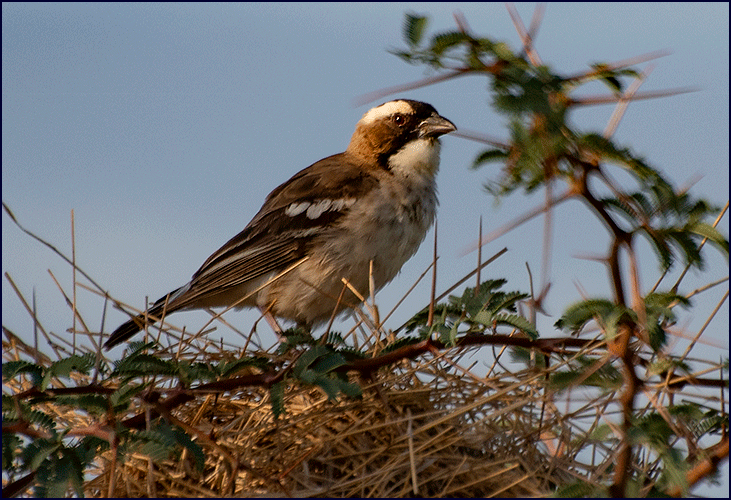
White-browed sparrow
weaver
|
Gee showed us honey badger tracks along the side of the
roadway. A tree squirrel dashed across in front of us and scurried
nimbly up a tree; he was very much like our squirrels at home, but
smaller. A white-browed sparrow weaver perched on the top of an
impressive nest; there were several empty decoy nests in the same
tree. We heard the ringing song of a brubru, also known as the
telephone bird, because its call sounds like a ringing phone.
|
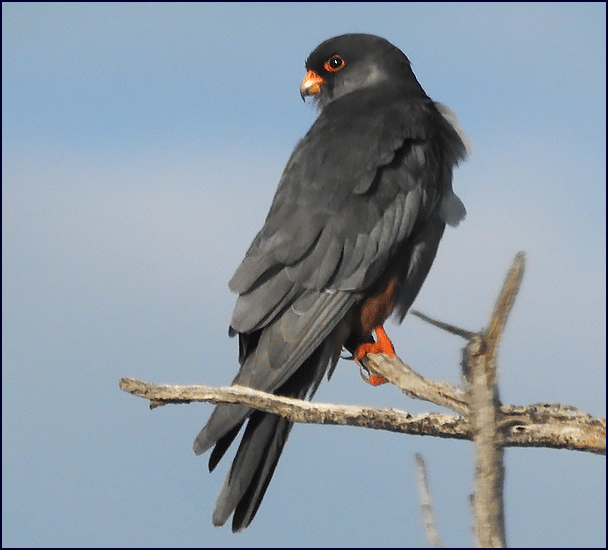
Red-footed falcon |
A
red-footed falcon perched on a branch; Gee said these birds are
very rare and this was only the second time he had ever seen one.
A group of banded mongoose moved smoothly among the bushes. A
tawny eagle stood sentinel in a treetop.
We passed a waterhole near the road, and there was a hyena
lying in the muddy water at its edge. She got up out of the water
and strolled right past our vehicle with her casual slouchy gait,
pausing to gaze at us as she passed, and then ambled on across the
road and disappeared into the bushes.
A little before nine o'clock we were travelling up a
winding green valley with mopane woodlands on the left and a
tree-dotted plain on the right; Gee called it the meeting of two
habitats. I was just thinking it was surprising that there were no
animals in sight when suddenly all hell broke loose. A large herd
of impala came bolting across in front of us, running for their
lives, and a pack of half a dozen wild dogs were streaking after
them! These were African wild dogs, some of nature’s most
efficient predators. They were running fast, hard on the heels of
the panicked antelopes. The impala leaped high, kicking their hind
legs up over their backs in a desperate effort to escape the pack.
|
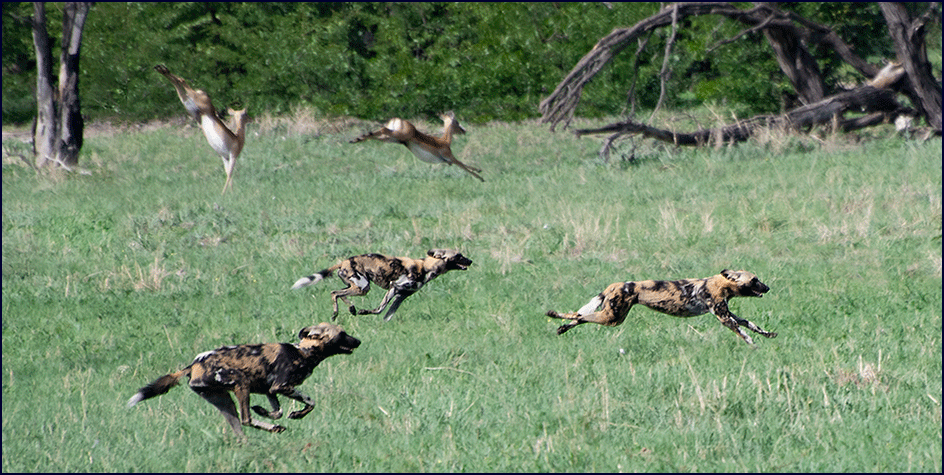
African wild dogs, on the hunt |
We followed them on the hunt, hanging on to the land
cruiser for dear life as Gee sped across the bumpy plain.
Following wild dogs as they hunt is about the most exhilarating
experience you can have on safari. The pack split; two went the
other way, but we followed four dogs speeding across the plain in
pursuit of their quarry. We were close behind them. Oh
my god, my father! This was incredible.
The dogs got a little ahead of us and
disappeared into the trees. We caught up with them just minutes
later; by that time they had not only killed an impala, but had
eaten most of it. Gee told us the dogs were a family; mom and dad,
and two youngsters, probably about two years old. As they were
finishing their meal another dog arrived; no doubt one of the two
who had split off from the pack. He escorted them (and we
followed) to another kill, where the sixth dog in the group
waited.
I love watching the African wild dogs; they remind me a bit
of my lurchers (greyhound crosses) at home. They have lean bodies
and long legs like a greyhound, and mottled black, chestnut and
white patchwork coats. They have a strong muzzle and jaw like a
German shepherd, with an impressive set of teeth, topped by large
round ears. They have tremendous speed and endurance, and they can
run their quarry until it drops. They have the highest successful
kill rate of any predator in Africa.
By now all six dogs had eaten their fill; their bellies bulged as
they lay down in the shade, quietly picking at the last morsels.
It was absolutely amazing to see how quickly the dogs had consumed
their kill. Several yellow-billed kites and a white-backed vulture
sat in the trees, waiting for their turn at the remains. We
watched the dogs a while longer, but when they settled down to
sleep we moved on.
|
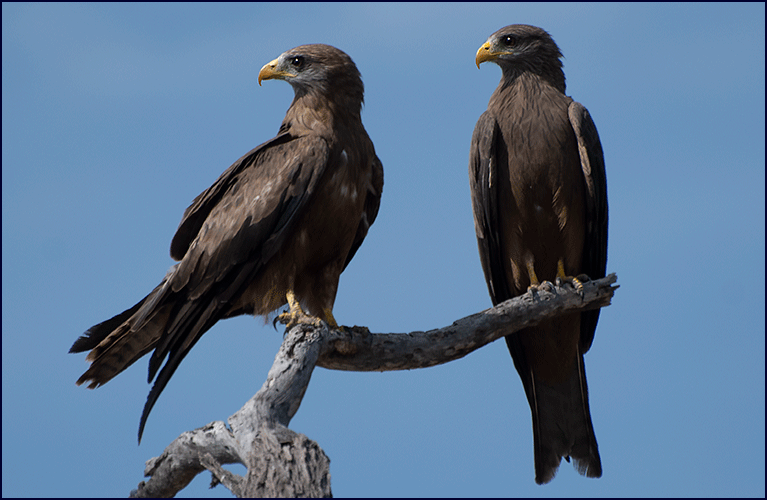
Yellow-billed kites |
~
Continued
on next page ~
Africa
2024 Pages:
1
2
3
4
5
6
7
8
9
10
11
12
Back
to the AFRICA 2024 INDEX Page
|